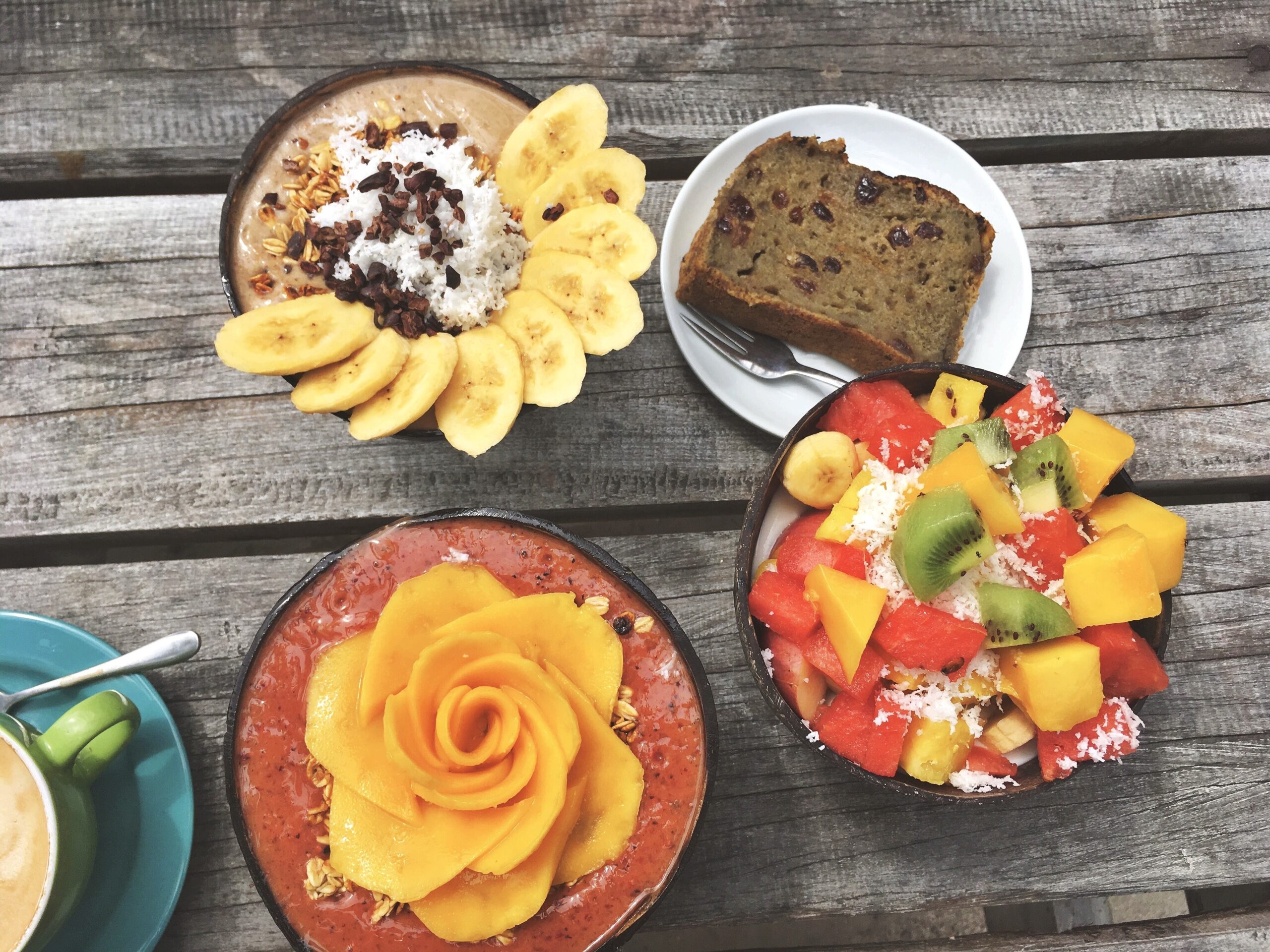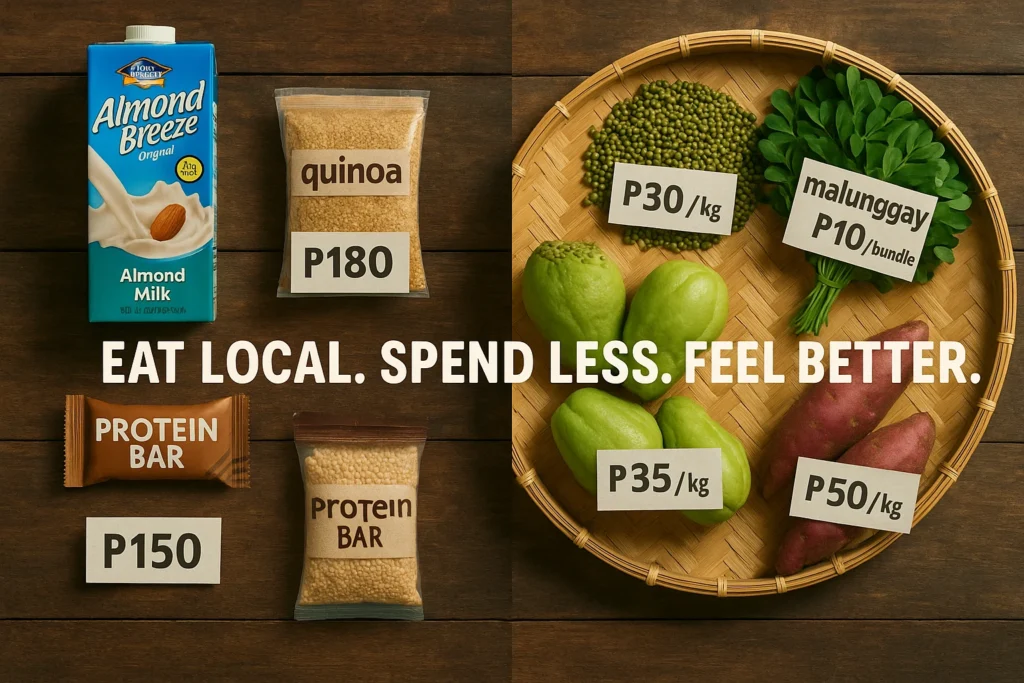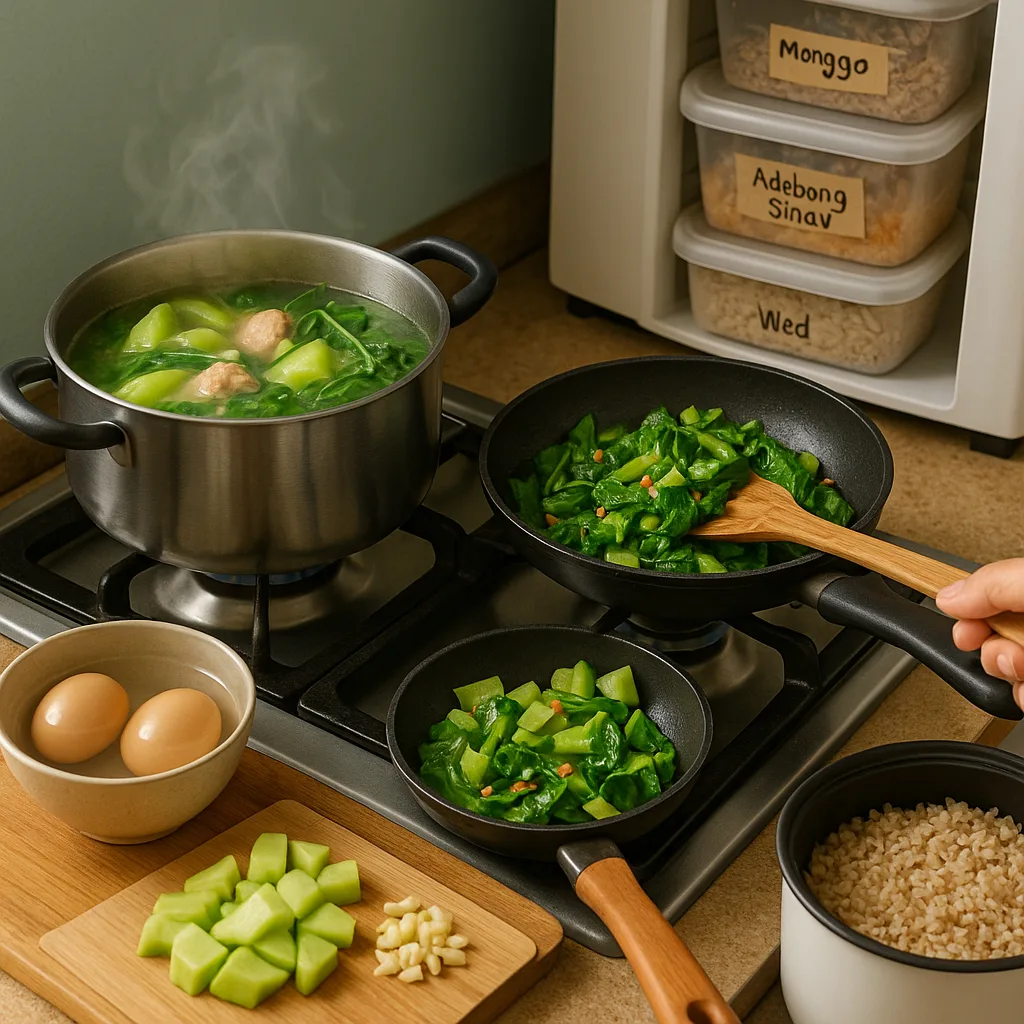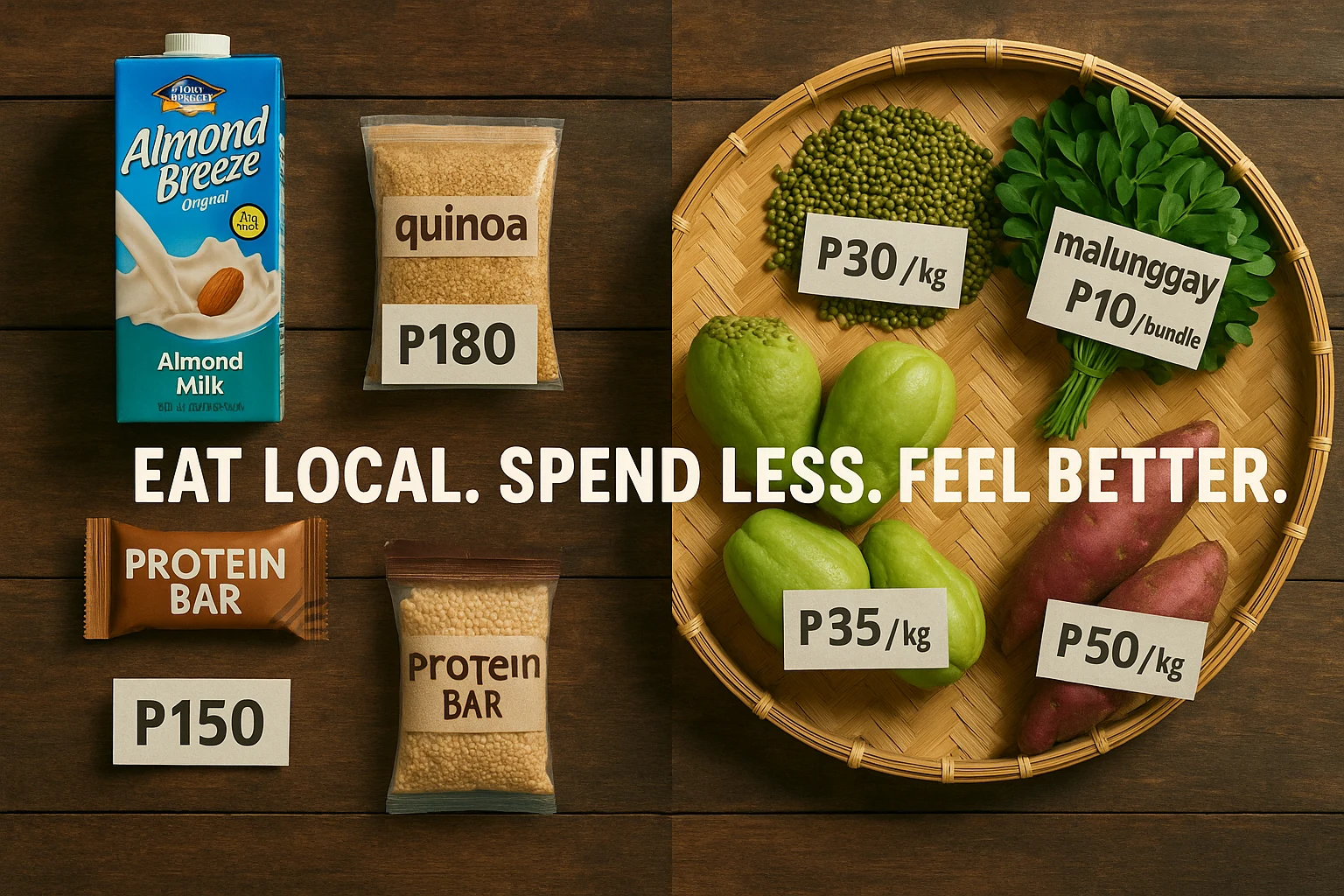Table of Contents
“A Filipino family of five spends an average of ₱8,379 per month on food.”
(Source: Philippine Statistics Authority)
That’s a huge chunk of the budget—and for many families, it still ends up being filled with instant noodles, canned goods, and fast food.
Our clients used to be the same. They thought eating healthy meant going to expensive organic stores, buying kale, quinoa, or almond milk. But when we made them take a step back and look at what was available locally, they realized they were wrong.
Eating healthy on a budget in the Philippines is totally possible. You don’t need fancy ingredients. You just need a few smart habits and a new way of looking at the food we’ve had around us all along.
Budget-Friendly Nutrition Doesn’t Mean Imported Food

Let’s face it—when you think of “healthy,” your brain might go straight to protein bars, imported oats, and stuff that comes in glossy packaging. Our clients were the same. They used to skip right past the local section and head straight for those foreign brands in the grocery, thinking, “Well, this must be what healthy is like.”
It’s not. And it doesn’t have to be. Eating healthy on a budget in the Philippines doesn’t mean emptying your wallet on so-called superfoods. It means embracing what’s already accessible and affordable.
One afternoon before going to the market, a client had ₱150 and no clue what to make for dinner. She asked me during our consultation, “Ma’am, anong pwede sa ₱150 na pang-dinner?” and I gave her a recipe for tinola and just like that, she was reminded how our local meals are packed with nutrients and heart. Affordable Pinoy meals like tinola, monggo, and tortang talong are not only delicious—they’re packed with nutrients.
Monggo, for example. Packed with fiber, plant-based protein, and iron. Pair it with malunggay—one of the most underrated greens we have—and you’re already giving your body a boost. I make a huge pot every week. It costs less than ₱50 to prepare and feeds me for days. With some fried garlic on top? Heaven. That’s eating healthy on a budget in the Philippines in action.
And then there’s tinola. It’s one of those soul-healing dishes, especially on rainy days. You don’t need fancy cuts of chicken. Use necks or wings. Sayote or green papaya. Add ginger, onions, and a bit of patis. That’s it. One pot can feed a whole family. You get budget-friendly nutrition, warmth, and comfort.
But healthy eating isn’t just about cooking. It’s also about what you don’t buy. When our clients stopped buying processed food, they realized they were actually saving money. No more ₱70 packs of cookies that disappear in one sitting. No more ₱50 sugar-loaded drinks. Just whole ingredients that stretch across multiple meals and support healthy living.
They also started checking labels. They were shocked at how many “healthy” snacks were full of sugar or sodium. That’s what healthy grocery in PH looks like—knowing what you’re buying, and choosing wisely.
So now, clients build their meals around what’s fresh, local, and cheap. Pechay, kangkong, kamote, itlog, saging. These are everyday ingredients that—when cooked right—taste amazing and fuel your body well. These staples are part of a budget-friendly nutrition toolkit.
If you’re just starting out and unsure how to balance meals or make a weekly plan, don’t worry. You’re not alone. Our clients got help, you can too. You can get real guidance tailored to your needs through our nutrition services in the Philippines. They’re affordable, practical, and sometimes all you need is a little nudge from someone who understands what your body really needs.
Eating healthy on a budget in the Philippines is about being intentional. It’s not about cutting everything out—it’s about choosing better, one meal at a time something we call budget-friendly nutrition. Healthy doesn’t have to mean expensive. It just has to make sense—for your body, your budget, and your lifestyle.
Meal Planning for Eating Healthy on a Budget in the Philippines

Meal planning doesn’t just help your wallet—it saves your time and sanity, too. According to a report by the Food and Nutrition Research Institute, many Filipino families overspend on snacks and processed food simply because of poor planning.
Back then, my clients walk into the grocery without a list and walk out ₱1,000 poorer—with nothing but biscuits, processed meats, and a few packs of noodles. When it was time to cook, they had “nothing to cook.” Sound familiar?
Now, they spend just 10 minutes each Saturday or Sunday mapping their meals for the week. It’s simple. they look at what they already have in the fridge, check what’s in season, and build their meals around those. This way, they use what they buy—and nothing goes to waste.
Here’s a sample 3-day meal plan I’ve personally used that costs more or less under ₱300. It focuses on affordable Pinoy meals, with budget-friendly nutrition in mind:
Day 1
- Breakfast: Boiled eggs + saging
- Lunch: Monggo with malunggay + rice
- Dinner: Tinola with sayote + rice
Day 2
- Breakfast: Oatmeal with peanut butter and banana slices
- Lunch: Tortang talong + rice
- Dinner: Ginisang pechay with tofu
Day 3
- Breakfast: Leftover rice + fried egg + kamatis
- Lunch: Adobong sitaw + rice
- Dinner: Galunggong + steamed vegetables
These aren’t fancy meals, but they’re filling, tasty, and give you real energy. That’s what eating healthy on a budget in the Philippines looks like in real life—not some Instagram version with avocado toast and chia pudding.
And here’s the best part: most of these affordable Pinoy meals can be stretched or modified depending on what’s available. If you have leftover tinola, you can add rice and make a light arroz caldo. Got extra monggo? You can throw in some ampalaya or kalabasa. Planning gives you that flexibility.
Another personal tip—repeat breakfast meals. You can have boiled eggs and fruit for two or three mornings in a row. It’s cheap, healthy, and you don’t have to overthink it while getting ready for work or school.
If you’re a beginner, start with one day at a time. List your meals for Monday. Once you get the hang of it, expand to 3 days. Eventually, you’ll find a rhythm that fits your schedule and appetite.
Lastly, involve your family or housemates. I ask mine what they want to eat, then I fit it into the budget. It saves me from complaints and reduces waste since everyone eats what they like.
Meal planning is more than a routine—it’s a mindset. And it’s one of the strongest tools you can use to make eating healthy on a budget in the Philippines sustainable.
Healthy Grocery in PH: Where to Buy Smart and Save

The grocery bill always used to surprise my clients. They would go in for a few basics and walk out ₱1,200 poorer—and they haven’t even bought meat yet. That’s when I realized that where you shop is just as important as what you buy. If you’re serious about eating healthy on a budget in the Philippines, the healthy grocery in PH mindset starts with smarter sourcing.
Supermarkets are great for comfort and convenience, but if you’re looking to stretch your peso while eating clean, it’s time to look local. Check your local market and see it for yourself. Everything is fresher. The prices? Way better.
Here’s what Ia client got on a recent Sunday at their neighborhood market:
- Pechay – ₱35/kg
- Carrots – ₱60/kg
- Malunggay – ₱10/bundle
- Eggs (1 dozen) – ₱85
- Galunggong – ₱90/half kg
- Kamote – ₱40/kg
That’s nearly a week of healthy meals, and they still had change from ₱400. Try doing that at a mall-based grocery and you’d barely make it past the produce section.
And it’s not just about the local markets. More and more people are selling farm goods directly from their backyards. I once found a Facebook Marketplace seller two blocks away offering organic lettuce and free-range eggs at half the price of the grocery. Fresher, cheaper, and I didn’t even need to travel far.
Here’s another pro tip: shop in the late afternoon. Vendors are more likely to give discounts to clear their stocks before closing. I’ve haggled for 3-for-₱20 sayote and got extra onions thrown in for free just because I smiled and bought in bulk.
Storage is key, too. If you’re going to buy in bulk to save money, learn how to store your produce right. Wrap leafy greens in newspaper or store in breathable bags to keep them fresh longer. Keep your eggs in a cool spot (but not too cold), and freeze your fish in portioned bags for easy cooking later.
The best part about all of this? You’re supporting small local vendors and farmers—real people, not just big brands. You’re investing in your health and your local economy. That’s a win-win.
If you’re unsure how to turn your affordable grocery haul into balanced meals, it’s totally okay to ask for help. You can consult a dietitian in Cebu and we can walk you through meal planning and food pairing that works for your lifestyle.
Once you embrace the healthy grocery in PH mindset, you’ll never look at ₱500 the same way again. You’ll see meals, nutrients, and value—not just price tags.
Affordable Pinoy Meals: Cook More, Waste Less

Cooking at home gives you full control over what goes into your food. It’s not just about saving money—it’s about feeding your body with intention. According to a study by the World Health Organization, home-cooked meals are generally lower in sugar, sodium, and unhealthy fats than takeout or fast food.
So now? Our clients cook most of their meals. And we tell them to keep things simple.
Every Sunday or Monday morning, they batch cook for the week. Even if you’re working full-time or parenting, this approach works with small adjustments. Here’s a typical routine:
- Boil a dozen eggs – Perfect for breakfast, snacks, or even as an meal with some kamatis and rice.
- Cook monggo – make a huge batch. Eat some fresh, freeze the rest for later in the week.
- Brown rice in bulk – portion it out into small containers. Reheat as needed.
One of my favorite budget hacks? Turning leftover tinola into arroz caldo. Just add rice, more water, a touch of ginger, and patis. Boom—new meal. Minimal effort.
Another tip: cook double portions. If you’re already chopping, slicing, or sautéing, why not make extra? It doesn’t take much more time, and it saves you stress during the week. We tell our clients to do this all the time with dishes like adobong sitaw, pinakbet, or ginisang ampalaya. They hold up well in the fridge and even taste better the next day.
You can also get creative with leftovers. Leftover fried fish? Turn it into a rice bowl with some fresh tomatoes and boiled egg. Tinapa flakes? Mix it with kamote or sautéed kangkong. You waste less, and you eat better.
Having a few go-to affordable Pinoy meals you know how to make quickly is a game-changer. Here are some of mine:
- Ginisang sardinas with sayote or pechay
- Tortang talong with kamatis and rice
- Adobong kangkong with fried egg
- Kamote cue and banana cue (for snacks!)
All of these cost very little, and they’re deeply satisfying. And trust me, when you cook more, you also become a better cook. You learn what works. You learn to trust your taste.
Cooking more at home helped clients reconnect with food. With culture. With their family.
So yes—cook more. Waste less. And enjoy meals that are good for your body, your budget, and your peace of mind.
Affordable, home-cooked meals aren’t just fuel. They’re freedom.
Eating Healthy on a Budget Philippines: Watch the Sugars
Sugar hides in plain sight—and it adds up fast. According to the Food and Nutrition Research Institute, the average Filipino consumes more sugar than recommended, much of it coming from beverages and snacks we assume are harmless. Even I learned that the hard way.
My clients thought they were doing okay. They drank those “healthy” teas from convenience stores, grabbed fruit-flavored yogurt for breakfast, and always had powdered juice at home. But one day, they noticed something off. I was tired after meals. Bloated. Craving sugar even more after they thought they had enough.
That’s when we helped them to cut back. At first, it was hard for them. Sugar is addictive. And it’s not just in desserts. It’s in ketchup, bread, canned goods—even some so-called healthy breakfast cereals.
We tell them to start small. Replace sweetened coffee with black coffee. It was bitter at first, but now they love it. We advise them to swap powdered juice for water with kalamansi—refreshing, tangy, and hydrating. And for afternoon breaks? Unsweetened tea, either cold or hot, depending on the mood. These became their daily drinks.
The change was almost instant. Within a week, they had more energy and less cravings. Their mood improved and they weren’t dragging by 3 PM like they used to. And their grocery bill got lower, too—since those flavored drinks were eating up at least ₱300 a week.
If you’re aiming for eating healthy on a budget in the Philippines, cutting sugar is a great place to start. It’s not about cutting everything sweet forever. Our clients still enjoy a slice of leche flan at parties or a scoop of halo-halo during summer. But they keep it occasional, not daily.
Another thing they do? they can read the nutrition labels. If the first ingredient is sugar—or anything that ends in “-ose”—they know to put it back. The less processed, the better. We’re so proud of them because they also learned to make their own snacks: banana with peanut butter, boiled saba, or even oatmeal with a bit of cinnamon. Tasty, healthy, and super affordable.
If you have kids, this is even more important. It’s so easy to hand them juice boxes or sugary biscuits. But small swaps—like water infused with fruit or homemade champorado with less sugar—make a difference over time.
Eating healthy on a budget in the Philippines means knowing what to cut out, just as much as knowing what to add in. Sugar is sneaky, but once you spot it, you’ll see how easy it is to take control.
So try it this week. Skip the sweet drinks. Choose water or black coffee. Make your own snack instead of buying one. You might be surprised at how much better you feel—and how much money you save in the process.
It’s a small shift, but it’s one of the most powerful ways to improve your health without spending a single extra peso. You’ll feel the impact within a week—no more crashes or bloated feeling after meals.
Healthy Habits and Eating on a Budget in the Philippines
Here’s the truth: eating healthy on a budget in the Philippines isn’t about giving up your favorite foods forever. You can still eat kwek-kwek when you pass by your favorite vendor. And it’s normal to still crave crispy liempo once in a while.
But 80% of the time, stick to home-cooked, fresh, simple meals. These are meals made with ingredients from a healthy grocery in PH—affordable, local, and nourishing. And your body will feel stronger for it.
It’s not about being perfect. It’s about being consistent. And choosing meals that make sense—both nutritionally and financially.
Final Thoughts on Eating Healthy on a Budget in the Philippines
The idea that healthy food has to be expensive? It’s a myth. With a little planning and the right mindset, you can enjoy affordable Pinoy meals, smart grocery habits, budget-friendly nutrition, and a consistent approach to eating healthy on a budget in the Philippines every day.
Start small. Replace just one meal with a home-cooked option. Bring lunch to work twice a week. Shop at your local market instead of the mall. Build habits around your local options, especially when it comes to your healthy grocery in PH. You’ll feel the difference—in your health, in your wallet, and in your daily energy.
You can also check out the DOST-FNRI’s Pinggang Pinoy to see how much you should be eating in each meal. If you’re ready to start building better habits—whether for your health, your household, or your brand—we’d love to help you. Start here and let’s build something sustainable together.




